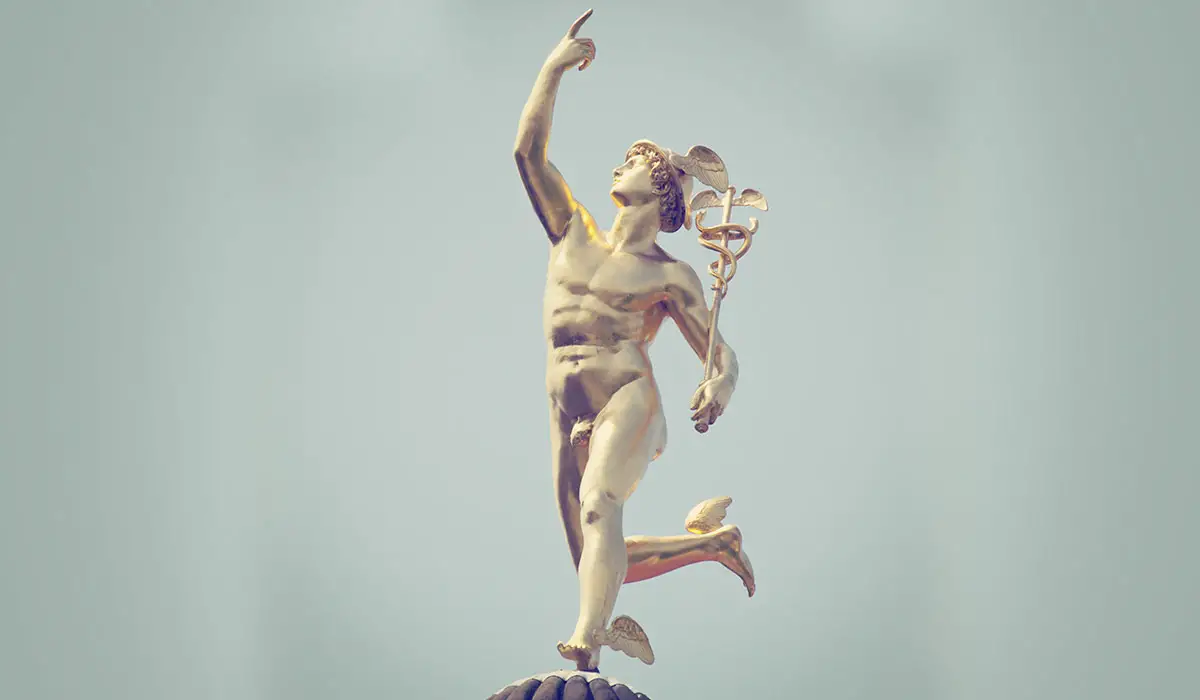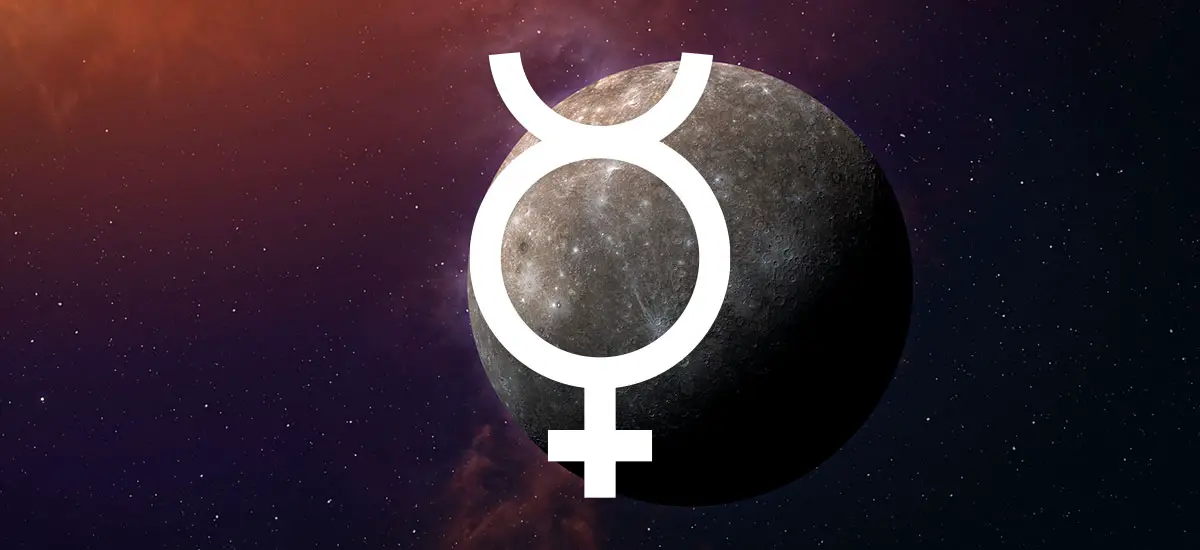In the world of Greek mythology, Hermes is portrayed holding the caduceus. In this article we are going to explore some of the facts and myths surrounding Hermes the Greek god as well as the caduceus symbol, and attempt to answer the question: Why did Hermes carry a caduceus?
Hermes carried the caduceus as a symbol of peace. It contains the magic wand, serpent, the double helix pattern of DNA, as well as wings. As the god of trade, wealth, language, thieves, and travel, Hermes used the symbolism and power of the caduceus to express his role in the universe.
The caduceus was an expression of his personality, and what he was meant to do during ancient Greece, and later became adopted as a symbol by various medical institutions.

Who Was Hermes?
Hermes is a deity in ancient Greek mythology, and one of the 12 Olympians gods. He is unique in Greek mythology in that he is the patron of such a diverse range of things. He is the god and protector of shepherds, travel, and literature, trade, wealth, luck, fertility, animal husbandry, sleep, language, and thieves. Considered clever and impish, he is most well known as the messenger between the gods and humanity. Hermes is also associated with the archetypes of the fool and the joker because of his precocious nature. He demonstrated how cleverness and trickery can be used to succeed in the game of life.
Hermes was the Messenger of the Gods
With a unique ability to transition between realms, Hermes was the messenger of the gods, moving between the world of the gods and the world of the mortals, communicating with humanity on behalf of Mount Olympus. He was often seen wearing a messenger’s cloak, brimmed hat, and winged sandals, as he delivered messages from his father Zeus.

The Caduceus was the Symbol of Hermes
Hermes’ symbol is the caduceus, a winged staff with two snakes intertwining and copulating. The caduceus has seen many variations over time, but has retained its essential elements of the intertwining snakes and wings.
The Caduceus was Given to Hermes from Apollo
According to Homer, Apollo gave Hermes the caduceus after a dispute between the two of them, which was settled by Zeus. Hermes was born in a cave in Mount Cyllene in Arcadia, southern Greece. After leaving the cave, he encountered a tortoise. He took the shell of the tortoise and used it along with reeds, ox hide, and strings made out of sheep guts to create the first lyre. The lyre was a popular stringed instrument in ancient Greece. He then quickly taught himself how to play, before continuing on his way
Hermes then stole 50 cattle from Apollo and hid them in a cave. Zeus determined that Hermes would keep the cattle but had to give Apollo the lyre instrument that he had made. Apollo was so thrilled with the lyre that he then gave the caduceus to Hermes as a gift. You can read more about Apollo here.
History of the Caduceus Symbol
The Caduceus symbol can be traced back to the Mesopotamian age, between 4000 and 3000 B.C. There was a Sumerian god named Ningishzida, who was god of the underworld, and also the messenger of the Earth Mother. Like Hermes, he too carried the caduceus. Also, a Sumerian ruler named Guea had a similar wand, with two copulating serpents wrapping around it.
In around 1400 BC, Moses used the bronze serpent erected on the pole to cure the people who were bitten by snakes.
The Meaning of the Caduceus Symbol
The Caduceus is loaded with rich symbolism, and represents the planet Mercury as well as the element of the same name. Within the caduceus, there is the magic wand, serpent, the double helix pattern of DNA, as well as wings.
The Wand
The symbol of the wand goes back to prehistorical times, and cave paintings have been found that depict figures holdings wands. Its use has gone unbroken throughout history, being popular in the medieval ages, as portrayed in the 1200s Latin grimoire (book of spells) The Oathbound Book of Honorius, and in the 1500s grimoire The Key of Solomon. It is typically used by practitioners of magic to focus their true will during magical ceremonies.
The Snakes
The two snakes can be traced back to the Sumerian origins of the symbol. According to Zacharia Sitchen, this early civilization was created as a hybrid between humans and reptilian beings from the planet Nibiru, whose religious and spiritual traditions were full of serpent symbolism. The snake symbol can also be traced back to Python at Delphi, who was slain by Apollo.
The Intertwining Pattern of the Snakes
The shape of the snakes is a reference to the double helix pattern of DNA. The higher realms of the gods had advanced knowledge of genetics, which was imparted to humans through Hermes. For example, during Hermes’ time as Thoth in ancient Egypt, the 42 books of hieroglyphs he created for the Egyptians were in reference to the 42 chromosomes of our DNA. The shape is also a reference to ascension beyond mortality, as Hermes was an immortal being who taught his followers how to obtain immortality as well.
The Wings
The wings are a symbol of travel and freedom. This was appropriate for Hermes as the messenger of the Gods, and the patron of travel. Wings also symbolize the aspiration of the soul for something higher.
Hermes Was Known as Mercury in Ancient Rome
Like most of the gods in ancient Greek mythology, Hermes lived on in ancient Rome but with a different name. It was the Romans who gave the planet the name Mercury, in honor of their god. Mercury especially affects humans when it goes into retrograde, causing bad luck in communication.
According to Roman legend, the symbol originated when Mercury once attempted to stop a fight between two snakes by throwing his rod at them, whereupon they twined themselves around the rod, and the symbol was born.
The element of mercury plays an important role in alchemy. It is the only metal to remain liquid at room temperature, which to practitioners of alchemy has been interpreted as a hint that it contains a profound secret. Many practitioners of alchemy believed that it was one of the main ingredients need to produce the philosophers stone, which can turn base metals into gold, and produce immortality. Mercury is not quite liquid, and not quite solid, and seems to exist in the transition between states, not unlike Hermes as he passed between the worlds of the gods, the mortals, and the underworld.

The Symbol for Mercury is Derived from the Caduceus and Winged Staff of Hermes.
Like all planets, the Mercury has a symbol. It is the same symbol used in alchemy to represent the element of mercury.
Other Deities to Carry the Caduceus
Besides the ancient Sumerian god Ningishzida, who was described earlier in this article. There have been other deities with the caduceus. One of them is Iris. Like Hermes, she is also a messenger, in particular for Hera the wife of Zeus. Also, Asclepius, the god of healing, had his own similar wand, called the Rod of Asclepius, which featured one snake instead of two.
The Caduceus Symbol in Modern Times
In modern times the caduceus continues to be a ubiquitous symbol, particularly in the medical field. In 1902 the caduceus was formally adopted as the symbol for the American medical department of the military. It is also used on multiple coats of arms, and flags, and by the US Army Medical Corps, the Public Health Service, and the US Marine Hospital. It is often confused
with the Rod of Asclepius, which the American Medical Association adopted as its symbol in 1910. This symbol is also used by the Royal Army Medical Corp, the French Military Service the World Health Organization, and the Medical Council of India, amongst others.
The wand part of the caduceus appears throughout modern culture as well. In British government, certain officials still have a wand as an official part of their office. In popular culture the wand has received greater attention thanks to the Harry Potter series of books and movies. Practitioners of various magical practices, including The Hermetic Order of the Golden Dawn, Thelema, and Wicca, use wands as part of their ceremonies.
Recommended Reading
If you want to continue exploring this subject more deeply, you can see which books I recommend by clicking here.

